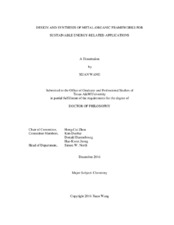| dc.description.abstract | Metal-organic frameworks (MOFs) are attracting because of their significant tunability, crystalline nature, permanent porosity, and tremendous surface area. These features make MOFs suitable for clean energetic applications, such as gas storage, biomedical applications, and catalysis. Till now, utilizing MOFs’ stability and functionality are challenging. In general, MOFs constructed from carboxylate linkers and soft metal ions are not very stable. Moreover, functionalization of MOFs during direct synthesis often comes with many difficulties. To address those two issues, two approaches—direct synthesis of MOFs from high-valence metals and post-synthetic metal metathesis—are in this dissertation.
By using the direct synthesis approach, one of my projects seek to synthesize a series of stable Zr-MOFs, PCN-56X (PCN stands for Porous Coordination Network), constructed from Zr6 clusters, which have been reported to exhibit remarkable chemical and thermal stability, and functionalized linear carboxylate linkers with fused rings and alkyl chains. Experimentally, some pendent groups on the linkers of these MOFs significantly utilize the packing efficiency of gas molecules and increase the total methane storage capacity. Furthermore, the PCN-56X series exhibite excellent moisture stability after exposure to laboratory conditions for six weeks.
Another project aims at building an anionic MOF to encapsulate the photocatalytic-active [Ru(bpy)3]^2+. The resultant PCN-99 framework is constructed by a tetrahedral [In(COO)4]-node and a specifically designed trigonal planar linker. The corresponding Ru@PCN-99 demonstrates excellent heterogeneous catalytic activities in oxidative hydroxylation of arylboronic acids under visible light with improved reusability.
Applying the post-synthetic metathesis approach, another project startes with a template of Mg-MOF PCN-430. During the exchange with the first row transition metals, four criteria, “Liability, Open metal sites, Energy stabilization, and Geometrical preference match (LOEG),” for complete metal metathesis are discovered. This discovery can be extremely useful in the functionalization of MOFs, which brings up more potential applications of MOFs. Following the FLEG guidance, the last project shows PCN-527-Cd with more Lewis acidic iron ions via applying the post-synthetic metathesis and oxidation method. The parent PCN-527-Cd demonstrates poor catalytic activity in one-pot deacetalization-Knoevenagel condensation reactions. However, the product PCN-527-Fe has a 100% catalytic activity. | en |


